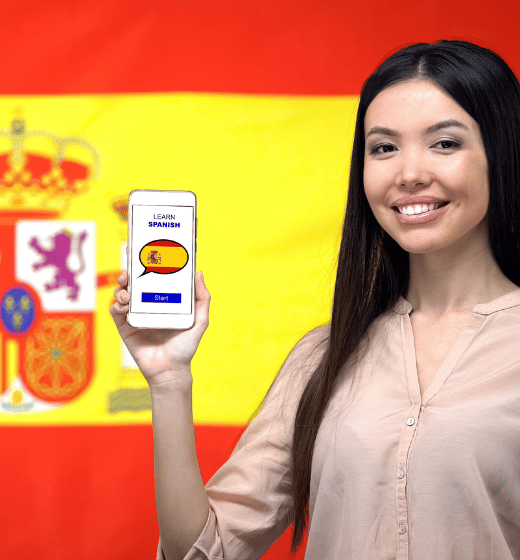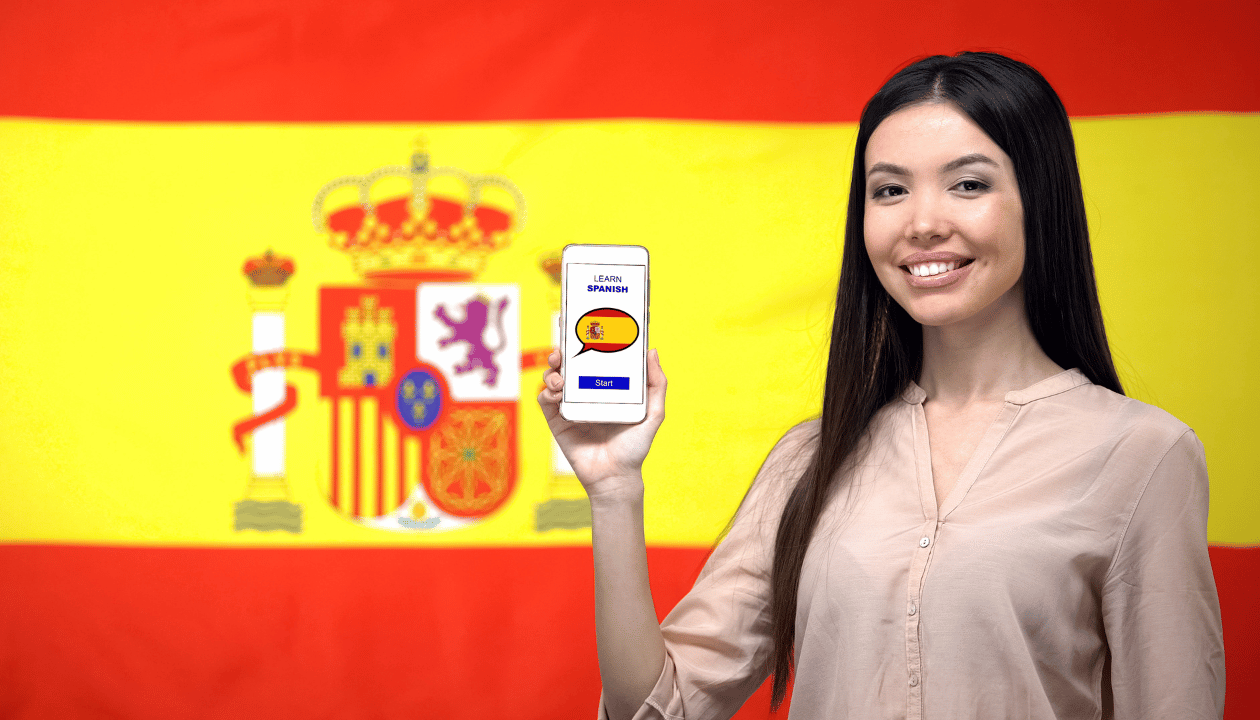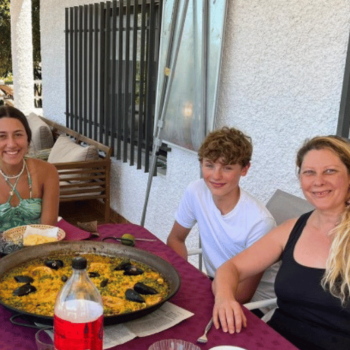

Looking for the best tips to learn Spanish? You’re in the right place! Our guide offers easy and enjoyable ways to improve your Spanish, even during a vacation.
Perfect for both new and improving learners, these tips make learning Spanish simple. From chatting with locals to using your phone for practice, every tip is a step towards fluency.
Start your language journey with us and discover how quickly you can learn Spanish!
Learn Spanish on your vacation
These tips will be useful for those who are learning Spanish for beginners. However, they are also a practice tool for intermediate and advanced learners.
So don’t hesitate to try them out and give your learning a boost.
1. Write down the new words you learn
For learning Spanish or any other language, taking notes will be key in the process. Writing down new words will help us not forget their meaning, and we will be able to add them to our vocabulary.
Take a small notebook and pencil with you, keep an eye on street signs, store names, among others. Sharpen your hearing and pay attention to people’s Spanish conversations.
Having your senses active while in a new country will keep you open and attentive to the knowledge it can give you about the language.
2. Engage with the locals
If you have already embarked on this adventure, you cannot miss the opportunity to mingle with the locals. This is not only a chance to learn about the country and its culture, but it will also be very helpful in acquiring new language skills.
The locals of a country handle more extensive terms and vocabulary since Spanish is their native language. In addition, it will encourage you to practice your speaking, since not everything can be left to theory.
It will be like having Spanish lessons in Spain, but with a more improvised plan.
3. Don’t be afraid to talk!
We understand that new things can be a little scary, and it’s normal to feel that way. But it is also important to face these obstacles, as it will be very helpful for your language development.
Fear is the worst enemy of learning Spanish. If you shy away from speaking, your learning will slow down.
Besides, you will be missing out on opportunities to gain knowledge, especially when engaging with locals in the country.
Conversation improves your pronunciation and expands your vocabulary. Take it step by step, at your own pace, but don’t give in to fear.
4. Make mistakes and you will learn
Part of the fear of speaking Spanish stems from the worry of making mistakes, but remember that it’s normal to fail, especially when you are learning something new.
Making mistakes will help you identify the flaws in your knowledge, and you will know how and what to improve, nurturing and boosting your performance in the Spanish language.
Do not expect to be a genius in your first class, this is something that not even the best Spanish course can achieve. Even having more time in the learning process will not make you a professional in the language right away.
Everyone learns at their own speed, and all knowledge acquired nourishes you, even if you don’t handle it like an expert. Be patient. Time and practice will give you the results you are looking for.
5. Listen to Spanish Music
Listening to Spanish music is a great way to improve your language skills. When you hear the rhythms and lyrics of Spanish songs, you start understanding the language better.
Music helps with learning new vocabulary and can also improve your listening skills. Try to sing along; this helps with speaking skills too.
Spanish music can include different dialects from Latin America and Spain, giving you a broader understanding. It’s not just about language; you also learn about the culture. Plus, it’s fun and you can do it anytime!
6. Watch Spanish Movies and TV Series
Watching Spanish movies and TV series is an excellent way to learn the language. When you watch, you hear native speakers in real-life situations.
This improves your listening and understanding of the language. Use Spanish subtitles to help understand what’s being said. You can also learn about different cultures and places.
Movies and TV series shows how Spanish is used in different contexts, which is really helpful. You don’t just learn words but also how to express emotions in Spanish. It’s entertaining and educational at the same time.
7. Practice Speaking Spanish Regularly
Practicing speaking Spanish as often as you can is key. Try to speak with native speakers. They can correct your mistakes and help you learn how to say things naturally.
Don’t worry about making mistakes; it’s part of learning. Speaking practice helps you become more fluent. You can start with simple words and phrases and then move to more complex conversations.
If you can’t find someone to speak with, try talking to yourself in Spanish. It’s about getting comfortable with the language.
8. Use Spanish Subtitles
Using Spanish subtitles while watching shows or movies is a great tool. It helps you connect spoken words with their written form.
This is good for reading skills and understanding how words are used in sentences. Subtitles can also show you how native speakers use the language in real life.
It’s a good way to learn new words and phrases. You can start with English subtitles and then switch to Spanish when you feel more confident. It’s a simple way to make watching TV a learning experience.
9. Learn Spanish Grammar and Vocabulary
Understanding Spanish grammar and vocabulary is important. Grammar rules help you form correct sentences.
Knowing vocabulary lets you express your thoughts. Start with basic rules and essential language skills. Then, move on to more complex vocabulary.
You can use flashcard apps to learn new words. Learning grammar might seem hard, but it’s important for speaking and writing correctly. Take it step by step and don’t rush. Be patient and keep practicing.
10. Use Spanish Learning Apps
Spanish learning apps are a great resource. They’re designed to make learning fun and interactive. These apps often have games, quizzes, and challenges to keep you engaged.
They cover different aspects of the language like grammar, vocabulary, and speaking skills. You can learn at your own pace, whenever you have time.
Some apps even connect you with native speakers for practicing speaking. It’s a convenient way to learn and you can see your progress over time.
11. Improve Your Spanish Pronunciation
To improve your Spanish pronunciation, a crucial part of language learning, focus on mimicking native Spanish speakers.
Listen closely to how they articulate words and try to replicate the sounds. Use language learning apps that have pronunciation guides.
Practice common phrases like “¿Qué hora es?” or “La casa” to get comfortable with the sounds of the language.
Recording yourself and comparing it to native speakers can be incredibly helpful. Remember, good pronunciation is essential to communicate effectively and be understood by others.
12. Explore Spanish Culture
Exploring Spanish culture enhances your language learning experience. Understanding the traditions, history, and lifestyle of Spanish-speaking countries provides context to the language.
Engage with Spanish music, watch TV series in Spanish, and read about Spanish customs and traditions. This cultural immersion will deepen your understanding of the language and make learning more enjoyable.
As you explore various aspects of Spanish culture, try to incorporate new vocabulary and phrases into your conversations. This approach enriches your learning and connects you more deeply with the language.
13. Practice with Flashcard Apps
Using flashcard apps is an efficient way to expand your Spanish vocabulary. These apps are designed to help language learners memorize new words and phrases quickly.
Focus on common and useful phrases, and gradually introduce more complex vocabulary. The repetitive nature of flashcards helps in ingraining words into your memory.
Regularly dedicating time to these apps can significantly improve your vocabulary and understanding of the language.
14. Speak with Native Spanish Speakers
Conversing with native Spanish speakers is invaluable. It’s an opportunity to practice speaking and listening in real-life situations.
Try to find native speakers or join language exchange programs. These interactions will not only improve your speaking and listening skills but also expose you to various accents and colloquialisms.
Don’t be afraid to make mistakes; they are an essential part of the learning process. Engaging in regular conversations will accelerate your journey to fluency.
15. Keep a Spanish Journal
Keeping a journal in Spanish is a great way to practice writing and thinking in the language. Write about your daily experiences, thoughts, or plans in Spanish.
This exercise helps in reinforcing new vocabulary and grammar rules you’ve learned. It also allows you to track your progress over time. Writing in a journal can be a peaceful and reflective way to enhance your language skills.
16. Learn Common Words and Phrases
Start by learning common words and phrases in Spanish. This foundational vocabulary is crucial for basic communication.
Focus on phrases that are frequently used in everyday conversations. Gradually, as you become more comfortable, expand your vocabulary to include more complex words and phrases.
Regular practice will make these words and phrases a natural part of your language repertoire.
17. Participate in Language Exchange
Participating in a language exchange is an effective way to practice Spanish. It involves partnering with a native Spanish speaker who wants to learn your language.
A mutual learning environment allows for practical conversation practice. It’s a great opportunity to enhance your speaking skills and learn about the cultural nuances of the language.
18. Focus on Conversational Spanish
Concentrating on conversational Spanish is crucial for practical communication. It involves learning phrases and expressions used in everyday conversations.
This form of practice helps you to think and respond quickly in Spanish, an essential skill for fluent communication. Engage in conversations about real-life topics to make your learning experience more relevant and engaging.
19. Explore Free Resources
There are numerous free resources available for learning Spanish. These include online courses, YouTube videos, podcasts, and language learning apps.
These resources often provide comprehensive lessons and exercises that cover various aspects of the language.
Utilize these tools to supplement your learning, especially to practice listening and speaking skills. Exploring a variety of resources can make your learning journey more diverse and enriching.
What is the trick to learning Spanish?
The trick to learning Spanish, as with learning languages in general, lies in immersing yourself fully in the language and starting to speak as early as possible.
Research suggests that full immersion is one of the most effective methods. This could involve surrounding yourself with Spanish media, practising with native speakers, or even traveling to Spanish-speaking countries.
For English speakers, it’s important to move beyond the comfort of your mother tongue and dive into Spanish. Focus on getting common phrases and words ingrained in your memory.
Begin with basic conjugation tables and simple two-word phrases, then gradually progress to more complex structures. The key is consistency and practical application in real-life scenarios.
Download Our Free E-Book on 10 TIPS FOR LEARNING SPANISH
Ready to learn Spanish?
Start learning Spanish with Spanish Express, and explore cities like Barcelona, Burgos, Cádiz, Girona, Madrid, Palma de Mallorca, and Valencia.
Each city offers a unique experience to enhance your language skills. From the lively streets of Madrid to the peaceful beaches of Cádiz and the historic beauty of Valencia, these places provide a vibrant backdrop for your studies.
Spanish Express connects you to these wonderful cities, blending language learning with the rich culture of Spain. Join us and make your Spanish learning journey unforgettable in these beautiful locations.
Can I learn Spanish in 3 months?
Yes, you can make significant progress in Spanish in 3 months, especially if you immerse yourself in the language through methods like watching YouTube videos in Spanish. Progress depends on how quickly you can get words ingrained in your memory and start speaking, even simple words. It’s about consistent practice at your own pace.
What is the secret to learning Spanish?
The secret to learning Spanish lies in consistent practice and immersion. For English speakers, it’s crucial to step outside the comfort zone of your mother tongue. Focus on learning and using two-word phrases initially, then gradually expand. Remember, regular use of the language is key.
What is the most accurate way to learn Spanish?
The most accurate way to learn Spanish involves a combination of practical usage and structured study. Start speaking from day one, even if it’s just simple words or phrases. Complement this with studying grammar and vocabulary. This method ensures a well-rounded grasp of the language.













